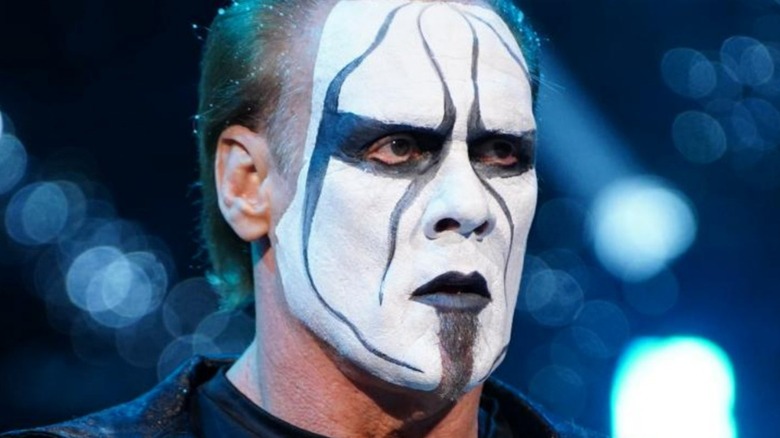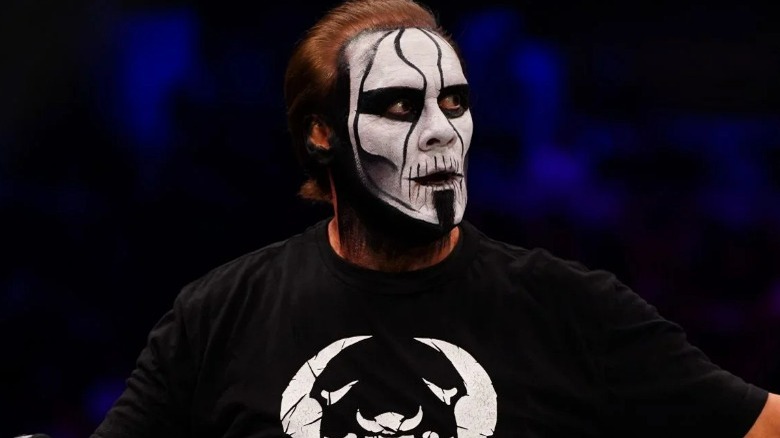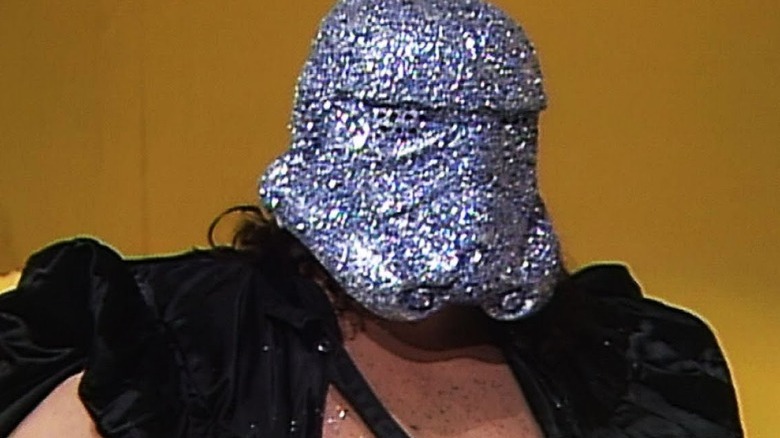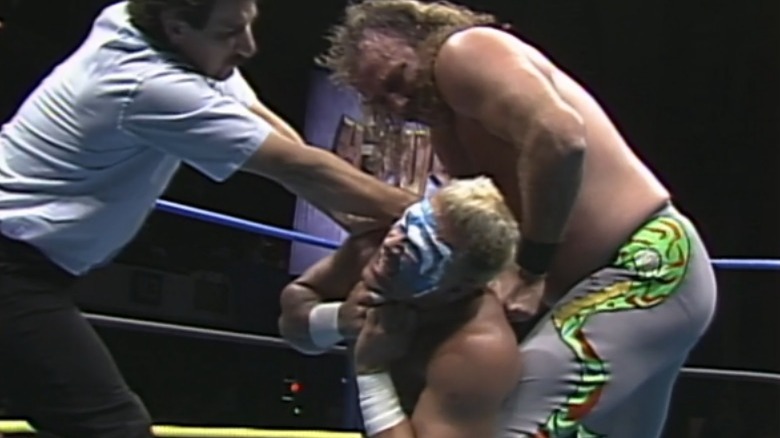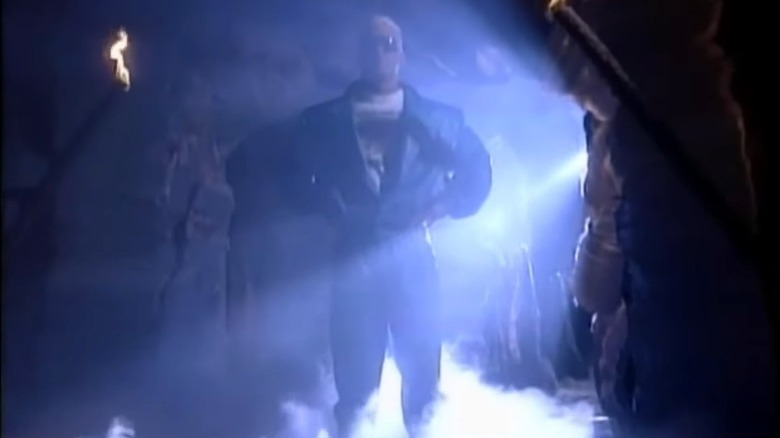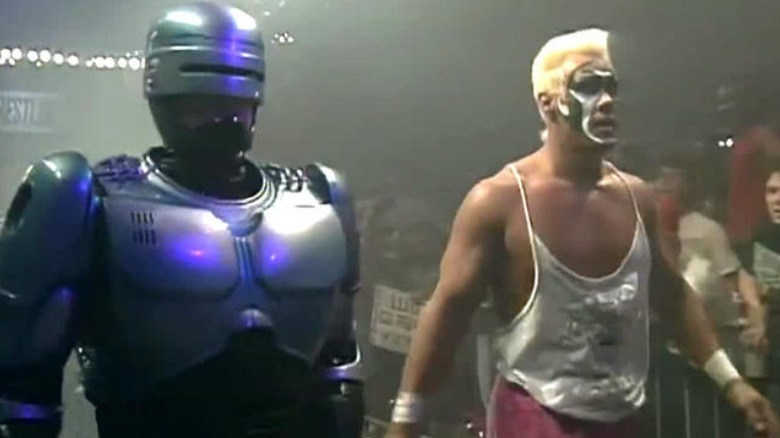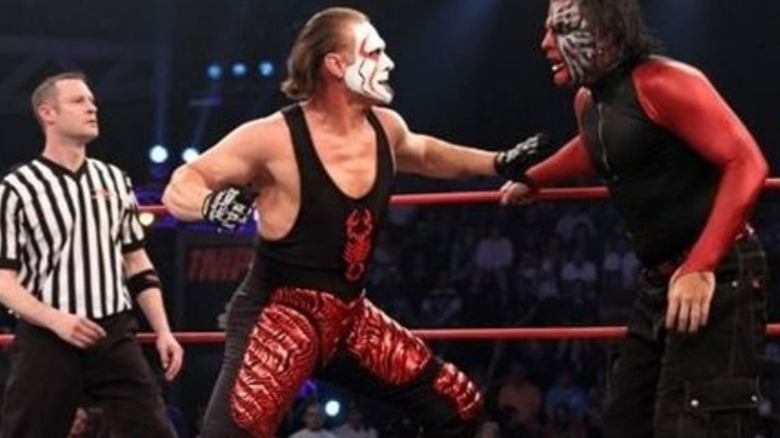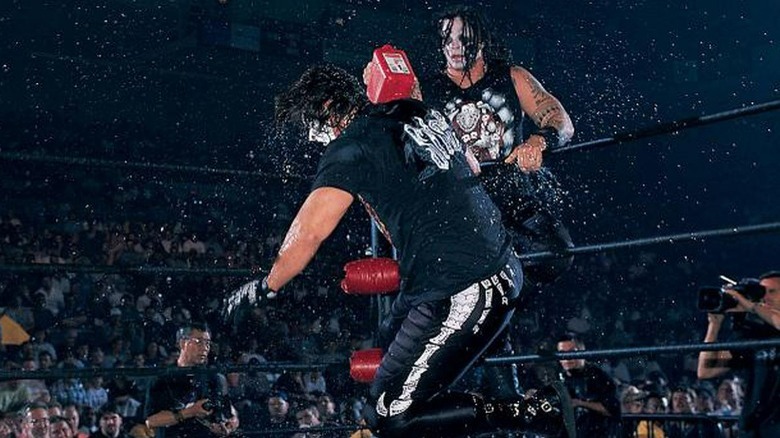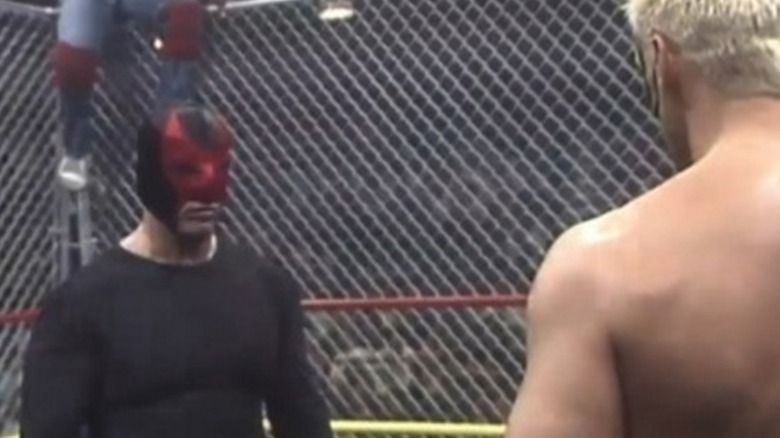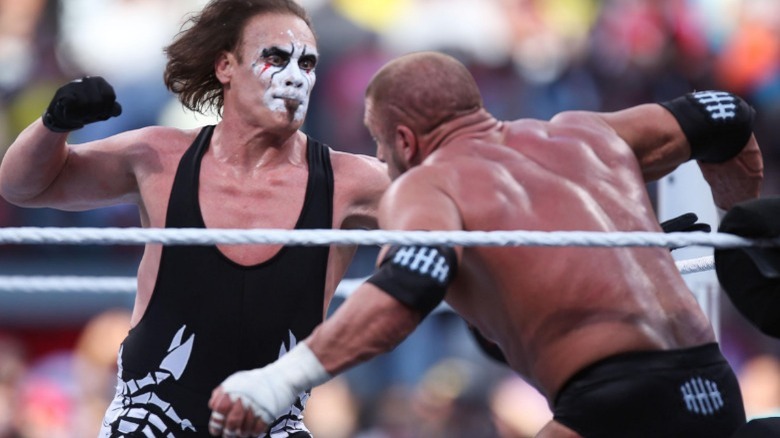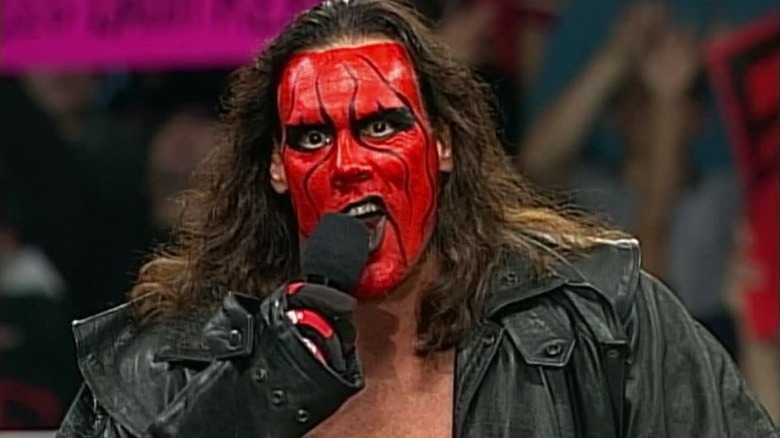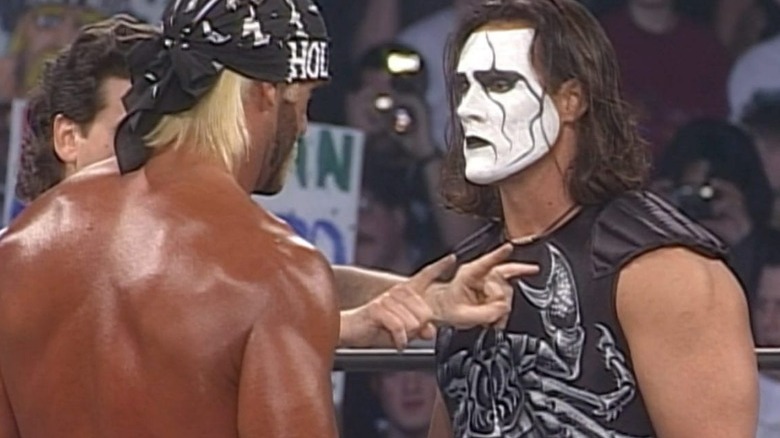The Most Questionable Moments Of Sting's Wrestling Career
The word "icon" gets tossed around a lot in professional wrestling circles, with fans deeming numerous wrestlers as deserving of the status. The Rock, Hulk Hogan, the Undertaker, and more have all been called the term in some form or fashion for their accomplishments between the ropes and their importance in wrestling history. Although, not a single one of them can lay claim to being "The Icon." That honor belongs to a man named Steve Borden, who has become one of the biggest names in wrestling under layers of face paint and the ring name Sting.
Since getting his start in wrestling in the mid-1980s, Sting has done nearly everything there is to do inside the squared circle. He's put on classic matches, won championship gold, and dazzled fans across generations — more than earning himself the nickname of "The Icon" in the process. Additionally, he's wrestled for nearly every major wrestling promotion under the sun, from World Championship Wrestling to WWE to All Elite Wrestling. This has afforded him the chance to work with a laundry list of wrestling's finest in unforgettable storylines.
Sting has enjoyed a stellar multi-decade career that has etched his name in the history books forevermore. However, when you've been in the business as long as him, you're bound to deal with some hiccups. These are the most questionable moments to come out of Sting's one-of-a-kind wrestling career so far.
Sting returns to the ring in AEW
Sting's career took an unexpected turn at the WWE Night of Champions event in 2015. He competed against Seth Rollins in a WWE Championship match, and when the champion went for a turnbuckle powerbomb, Sting severely injured his neck on impact. Not only did this end the match prematurely, but at the 2016 WWE Hall of Fame ceremony, "The Icon" announced that the injury had cut his career short as well. With that, it seemed like wrestling fans had seen the last of Sting as an in-ring competitor, but that notion was dismissed a few years later at the AEW Winter is Coming event.
Following a tag team match that saw Cody Rhodes and Darby Allin defeat Ricky Starks and Powerhouse Hobbs, Sting made his AEW television debut. This was a shocking moment and one that had many fans excited, but once that excitement wore off, the skepticism set in. If Sting was indeed part of the AEW roster for the long-haul, could he and should he compete? After all, he was a legend at this point with nothing really left to prove, and the last time he laced up his boots, it ended with a horrific injury. Despite widespread uncertainty toward his return, Sting went full steam ahead to become an active presence on AEW TV.
Years have passed since Sting returned to the ring under the AEW banner, and while his run hasn't been perfect, it's fair to say he's made the most of it. With Darby Allin at his side, he's embarked on a string of entertaining matches and has proven that his neck injury was far from the level of severity we were all led to believe it was. Sting's AEW debut may have been questionable at first, but it has since worked out for the best.
Sting introduces the Shockmaster
With WCW Fall Brawl 1993 approaching, a WarGames match featuring the team of Sid Vicious, Vader, Kane (not the Kane you're thinking of), and Kole against Sting, Dustin Rhodes, and Davey Boy Smith was added to the card. As you can likely tell, Sting's team was missing one member to make it an even four-on-four contest. Luckily, they had one final member to introduce, and they'd do so on an installment of the "Flair for the Gold" interview segment at Clash of the Champions XXIV. What could've been a grand moment quickly devolved into a disaster of infamous yet hilarious proportions.
As Sting and Smith spoke with "The Nature Boy" Ric Flair, Sid, Kane, and Kole forced their way into the conversation to demand the identity of their mystery Fall Brawl opponent. With all the excitement and confidence he could muster, the Stinger let the world know that their partner would shock the world since he is the Shockmaster (aka Fred Ottman, or as WWF audiences knew him, Tugboat and later Typhoon). On the opposite end of the "Flair for the Gold" set, two small flames erupted from the floor as a man burst through the wall. Falling directly on his face, his bedazzled Stormtrooper helmet fell off, prompting him to scramble to put it back on and rise to his feet.
Once up, the Shockmaster tried to strike fear into the hearts of his Fall Brawl opponents with his menacing voice — as provided by Ole Anderson off-camera — but the jig was up. The Shockmaster swiftly became the laughing stock of the wrestling world from the literal moment he introduced himself to WCW audiences. In the years since, he's become an iconic wrestling character for all the wrong reasons, and poor Sting will always be linked to his immediate failure.
Sting's Coal Miner's Glove match against Jake Roberts
After a run in the WWF, Jake "The Snake" Roberts made his way to WCW in 1992 and immediately took aim at one of its top stars: Sting. He made his debut in August by running in from the crowd to attack him, prompting a singles match on "WCW Worldwide." Come Clash of the Champions XX, they'd battle on opposite sides of a four-on-four tag team match that ended with Roberts scoring the pinfall on his new rival. To close out their feud, they'd meet one-on-one at Halloween Havoc 1992 in a match that proved to be anything but an instant classic.
For Sting and Roberts' third and final WCW encounter, they were at the mercy of Spin the Wheel, Make the Deal rules. This entailed a wheel full of match stipulations being spun and whatever match type it landed on is what they'd have to work with. It would land on the Coal Miner's Glove stipulation: a match where a leather glove is attached to a pole and competitors can retrieve it to use on their opponents. It's no controversial statement to say that the match was incredibly disappointing for a contest between two all-time wrestling greats and a bland end to a feud that, on paper, had loads of potential.
Sting and Jake Roberts have both taken part in matches that fans will never forget, and their Halloween Havoc 1992 clash is certainly among them. Although, compared to the rest this is one of the few that's remembered because it was so uninteresting. In fact, Roberts has even claimed it's among his worst matches ever (via The Two Man Power Trip of Wrestling Podcast), and looking back, it's hard to disagree.
Sting enters the White Castle of Fear
Throughout his extended tenure in WCW, Sting would lock up with some of his biggest in-ring rivals. "Nature Boy" Ric Flair, Hulk Hogan, and more all became integral parts of the Stinger's legacy in the company, and Big Van Vader proved no exception. After a couple of matches, their feud began in earnest in early 1992 as the behemoth sought to become WCW World Champion at Sting's expense. In an impressive showing, Vader won the gold at the 1992 Great American Bash, and while Sting was very much banged up following the encounter, his war against his dangerous enemy was far from over.
Moving into 1993, Sting and Vader's rivalry once again picked up steam ahead of the SuperBrawl III event. While the match itself is among their best, it's one of the pre-taped promos ahead of it that fans still remember all these years later. On the January 30 edition of "WCW Worldwide," Sting boarded a helicopter with an invitation from Vader himself to visit the White Castle of Fear located in the Rocky Mountains. When he arrived, he was greeted by party guests and soon Vader himself, who challenged him to a "game" — a tug-of-war using a leather strap over a flaming table. The segment ended before we saw who won.
Between the cheesy dialog, over-the-top set, hilariously poor editing, and incredibly dated (yet seriously catchy) music, the White Castle of Fear promo is an odd relic from Sting's WCW career. To promote their SuperBrawl III match, he and Vader, as well as the latter's manager, Harley Race, hammed it up in what's easy to look at now as one of the promotion's corniest segments. It's more than memorable, but the reasons for it becoming so well-known certainly lean in a negative direction as opposed to a positive one.
Sting teams with RoboCop
Sting has spent the bulk of his career as a singles competitor, but time and time again he's shown off his abilities as a team player when necessary. For instance, when he first broke into wrestling, he joined fellow upstart Jim Hellwig — future wrestling superstar the Ultimate Warrior — to form the Freedom Fighters and later the Blade Runners. In the years that followed, he forged alliances with Lex Luger, "Macho Man" Randy Savage, and more, most recently tagging with Darby Allin in AEW. However, only one of his many famous allies can claim to be half man, half machine: RoboCop.
Yes, for those unaware, the title character of the 1987 classic "RoboCop" did indeed appear on WCW television at Sting's side. It all went down at Capital Combat: Return of RoboCop in 1990, a pay-per-view that wore its cross-promotion with "RoboCop 2" like a badge of honor. During the event, Sting welcomed RoboCop himself to the arena, but the Four Horsemen wouldn't let this moment go off without a hitch. Sid Vicious and Arn and Ole Anderson locked Sting in a cage, prompting RoboCop to ever so slowly make his way to ringside and free the Stinger from his prison. The Horsemen backed off in short order.
"RoboCop" is an excellent film about an interesting character, but let's be honest, he had no place in WCW. The entire segment he featured in was lame and it couldn't have come across more like an advertisement for "RoboCop 2" if it tried. To this day, Sting isn't proud of the moment, and it doesn't take a detective to figure out why. If nothing else, he still has a good laugh about it once in a while (via Bleacher Report).
Sting becomes the 'Insane Icon'
When WCW closed its doors in 2001, so began Sting's brief absence from the mainstream wrestling scene. Unlike many WCW alums, he didn't jump ship to the WWF in the early 2000s, instead choosing to appear sporadically for World Wrestling All-Stars from 2002 to 2003. From there, he hopped over to Total Nonstop Action Wrestling, where he'd remain until 2014. Throughout his TNA run, Sting further solidified himself as wrestling's "Icon," but this stint wasn't perfect. In the eyes of many wrestling fans, the low point came in the form of the "Insane Icon" or "Joker Sting" storyline.
In 2011, Sting's personality shifted dramatically. Instead of the calm, collected, and methodical version of him TNA fans had come to know, he became loud, jokey, and unpredictable. He even smeared his face paint into a twisted smile to resemble the late Heath Ledger's Joker from 2008's "The Dark Knight." Throughout much of the year, this unhinged Sting terrorized the Immortal faction — mainly its leader, Hulk Hogan, as well as Ric Flair and Mr. Anderson — and came close to winning the TNA Heavyweight Championship before successfully getting TNA back into the hands of its rightful owner, Dixie Carter.
From the moment Sting became "The Insane Icon," wrestling fans everywhere collectively rolled their eyes. Why would an undisputed in-ring legend stoop so low to reinvent himself in such a hokey, comical way in a company that had quickly lost so much goodwill with audiences? This iteration of Sting certainly has its supporters – including Sting himself, who cited his appreciation for it on an episode of "Table for 3" on the Peacock streaming service – but as the years have gone on, it has become increasingly clear that it's not one for which the vast majority of wrestling enthusiasts have much love.
Sting faces Jeff Hardy at Victory Road 2011
Sting took some time away from the ring at the end of 2010, but when he returned, he did so in the biggest way possible. On February 24, 2011, then-TNA Heavyweight Champion Jeff Hardy was booked in a match against a mystery challenger, and sure enough, "The Icon" answered the call. He promptly defeated Hardy in a match that spanned just over six minutes to become the TNA Heavyweight Champion for the third time in his career. Instead of moving on after the loss, Hardy kept his eyes firmly on the gold, which led to a title rematch at March's now-infamous Victory Road 2011 pay-per-view.
What could've been a standout match between two wrestling favorites devolved into an embarrassing mess for all involved before the bell even rang. When Jeff Hardy came down the ramp that night acting more erratic than usual, something was clearly wrong. As it turns out, Hardy had taken Somas — a form of muscle relaxer — before the match, rendering him in no shape to compete. With him and Sting in the ring, on-screen authority figure Eric Bischoff came out to join them so he could give the latter instructions on how to proceed. Sting forced a pinfall on Hardy and angrily left the ring after this match that ran less than two minutes.
Not only has this become one of the most questionable moments in Sting's career, but it still haunts discussions of Impact Wrestling over a decade later. As Jeff Hardy explained on his "Broken Skull Sessions" appearance, he's deeply ashamed of how this main event match — if you can call it that — panned out. Simply put, the bout shouldn't have taken place, but what's done is done.
Sting takes part in a Human Torch match
In the waning days of WCW, Sting had the opportunity to work with some folks that he didn't normally work with. One of these names was Vampiro, who'd arrived in WCW in 1998 after honing his craft in Mexico and Japan. Come 2000, he'd begin to feature more prominently as asn upper-midcard star, hence why he teamed up with Sting to form the tag team known as the Brothers in Paint. However, as the year wore on and Vince Russo and Eric Bischoff "rebooted" WCW, they'd end up on opposite ends of the ring and begin what one could only describe as a feud fit for WCW programming in 2000.
Heading into The Great American Bash 2000, Vampiro struck up an odd fascination with lighting Sting on fire. This led to a Human Torch match between them at the pay-per-view, where they'd brawl and attempt to set each other ablaze in order to win. Their confrontation brought them to the top of the entrance screen, where Sting — or, rather, a stand-in for Sting, as noted by IGN at the time — would be set on fire and fall onto the stage below. Arena personnel quickly came in to hose him down using fire extinguishers as Vampiro celebrated his victory. With that, the Sting-Vampiro program effectively ended.
Both Vampiro and Sting were involved in several entertaining matches and feuds throughout their respective WCW runs, but their rivalry never really clicked. To make matters worse, their Human Torch match was both dull and, as some would argue, in bad taste. The wrestling world was still reeling from Owen Hart's unexpected death during WWF Over the Edge 1999, where he fell from roughly 78 feet in the air in a freak accident. The parallels between his fall and that of the fake Sting were too uncomfortable to bear.
Sting unmasks the Black Scorpion
Sting reached the pinnacle of the National Wrestling Alliance at the 1990 edition of the Great American Bash. He battled and defeated "Nature Boy" Ric Flair to become the NWA World Heavyweight Champion for the first time, cementing himself as a top star in the wrestling world. Sadly for Sting, winning the gold meant getting a giant target placed on his back, as other wrestlers attempted to make the most of their shots at the gold. Worse yet, the main person who tried to take the title from him was someone the Stinger had no idea how to combat: The Black Scorpion.
Not long after Sting won the title, the mysterious Black Scorpion began to appear on television, taunting the champion from afar. This led to a match between them at Clash of the Champions XII, where Sting nearly revealed the identity of the Black Scorpion but ultimately couldn't pull off his mask. The mind games continued in the aftermath as the Black Scorpion continued to display supernatural abilities and imply that he and Sting had a history. Ever a fighting champion, Sting gave the Black Scorpion another shot at the gold at Starrcade '90: Collision Course, but if he lost, he'd have to reveal his identity.
Yet again, the Black Scorpion failed to defeat Sting, so he had no choice but to unmask. In a rather deflating twist, it turned out that the Black Scorpion was Ric Flair in disguise. Granted, in that era, it was hard to complain about seeing Sting and Flair wrestle, but given the suspense and intrigue surrounding the Black Scorpion character, Flair being the one behind it all was just too disappointing. According to Jim Ross, who was in the company at the time, the Black Scorpion angle was a prime example of poor planning from the very beginning.
Sting loses to Triple H at WrestleMania 31
When Sting made his long-awaited WWE debut at the 2014 Survivor Series event, wrestling fans were just as shocked as they were excited. He'd spent years telling the world that he'd never join the company, yet here he was, more than ready to embark on a new chapter of his career. With WrestleMania 31 on the horizon, the next logical question people would ask is who will Sting face on wrestling's biggest stage? Could we see the dream match of all dream matches in Sting versus the Undertaker? Or perhaps the Stinger would battle the arguable face of WWE, John Cena? Nope, that honor would go to Triple H.
The seeds were planted for Sting versus Triple H at Survivor Series, when the former attacked "The Game" to help Team Cena to victory. As the road to WrestleMania began, they'd kick their feud into high-gear, with it being billed as the final battle of the WCW-WWE Monday Night War. Not only was this Sting's first WrestleMania match, but it was also his first WWE match, so expectations were high to say the least. While the one-on-one portions were fine, once the New World Order (Kevin Nash, Hulk Hogan, and Scott Hall) and D-Generation X (Shawn Michaels, X-Pac, Billy Gunn, and Road Dogg) got involved, the match declined in quality significantly.
To top it all off, Triple H scored the victory over Sting in a decision that fans almost immediately took personally. Yes, Sting is a wrestling icon, and the loss didn't necessarily hurt his image as such. At the same time, though, this was his first in-ring performance in WWE, so a win would've gone a long way here. Not to mention, it would've been a WrestleMania moment for the ages. As Sting's career winds down outside of WWE, it's unlikely we'll ever see him between the ropes at WrestleMania again.
Sting joins the NWO Wolfpac
When the NWO kicked down the doors of WCW, it was initially a fairly contained threat. Scott Hall and Kevin Nash caused a little trouble, and they only got worse once Hulk Hogan revealed himself as their companion. However, within a few short months, the faction started to grow, adding members left and right that fans once believed were loyal to WCW no matter what. Even the mastermind behind "WCW Monday Nitro," Eric Bischoff, as well as other backstage personnel, donned the black and white. One of the few people who didn't bend the knee to the NWO was Sting, who made it his mission to take down the group and defend WCW's honor.
As 1998 rolled on, the NWO was still incredibly popular with fans and dominated WCW programming, but it was more than time for a change. In May, the faction split in half, with the NWO Wolfpac sporting red and black while NWO Hollywood kept the classic black and white. Of the two sides, the Kevin Nash-led Wolfpac was the clear fan-favorite, and it only became more beloved when Sting made the bold decision to join the group in June. Both NWO groups had previously attempted to sway him to their side, with Sting torn over the decision since he had allies on both sides of the conflict.
While the NWO Wolfpac was the cool new thing at the time, seeing Sting wear anything with an NWO logo is still a strange fit. He'd spent years as a staunch WCW supporter, so for him to move to the NWO — no matter the incarnation — raised some eyebrows from a pure logic standpoint. Still, that's not to say that the red and black version of his "Crow"-inspired face paint isn't one of Sting's most badass looks.
Sting's match with Hulk Hogan at Starrcade 1997
Before he'd don the red and black as a member of the NWO Wolfpac, Sting was a very different man. Throughout 1996 and 1997, he was a stoic, brooding individual, who'd seen WCW go from a thriving wrestling platform to a chaotic and dangerous place where the NWO ruled over all. For over a year, Sting didn't compete in the ring on television nor did he speak, allowing his actions to do the talking. Of course, he wasn't difficult to understand in the least. He wanted the leader of the NWO, "Hollywood" Hulk Hogan, in a match for the WCW Championship — a bout that came to fruition at Starrcade 1997.
It all came down to this. With the very soul of WCW on the line, Sting confronted Hogan at Starrcade with the title up for grabs. If he wanted to defeat the NWO once and for all, now was the time to do it, crushing its leader and taking back the WCW Championship. While he did beat Hogan and take home the gold for WCW, the match didn't deliver by pretty much any metric. The wrestling was slow, Hogan got the better of Sting for most of the match, and a match restart following a referee change from NWO member Nick Patrick to Bret "Hitman" Hart made this main event tremendously underwhelming.
It's widely agreed that the Starrcade 1997 main event should've been an easy layup for WCW. The story was compelling and the star power between "Hollywood" Hogan and Sting was off the charts at the time. The fact that WCW fans hadn't seen Sting wrestle on pay-per-view in ages should've worked in the company's favor, too. Alas, a slow-moving match coupled with an overbooked finish is what fans got, and even all these years later, it's baffling how WCW managed to mess this one up.
